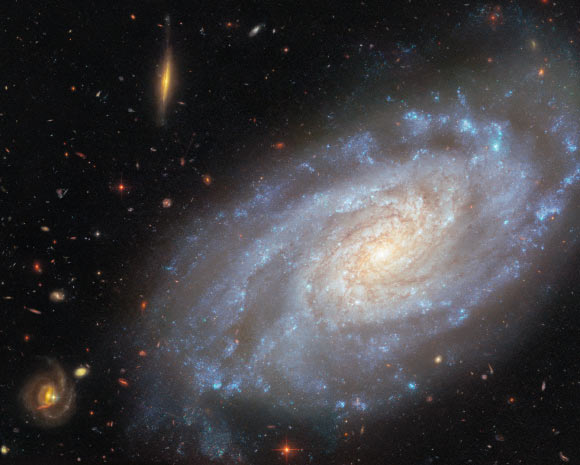Astronomers using the NASA/ESA Hubble Space Telescope have obtained a new image of the nearly face-on spiral galaxy NGC 3370.

This Hubble image shows NGC 3370, a spiral galaxy some 90 million light-years away in the constellation of Leo. Image credit: NASA / ESA / Hubble / A. Riess / K. Noll.
NGC 3370 is located approximately 90 million light-years away from Earth in the constellation of Leo.
Otherwise known as the Silverado Galaxy, IRAS 10444+1732, LEDA 32207 or UGC 5887, this galaxy is nearly comparable to our Milky Way both in diameter and mass.
NGC 3370 was first discovered by the German-British astronomer William Herschel on March 21, 1784.
It is a member of the NGC 3370 group of galaxies along with NGC 3447 and NGC 3455.
NGC 3370 is home to two kinds of objects that astronomers prize for their usefulness in determining distances to faraway galaxies: Cepheid variable stars and Type Ia supernovae.
“Cepheid variable stars change in both size and temperature as they pulsate,” the Hubble astronomers said in a statement.
“As a result, the luminosity of these stars varies over a period of days to months.”
“It does so in a way that reveals something important: the more luminous a Cepheid variable star is, the more slowly it pulsates.”
“By measuring how long a Cepheid variable’s brightness takes to complete one cycle, we can determine how bright the star actually is.”
“Paired with how bright the star appears from Earth, this information gives the distance to the star and its home galaxy.”
“Type Ia supernovae provide a way to measure distances in a single explosive burst rather than through regular brightness variations.”
“These explosions happen when the dead core of a star ignites in a sudden flare of nuclear fusion.”
“They peak at very similar luminosities, and much like for a Cepheid variable star, knowing the intrinsic brightness of a supernova explosion allows for its distance to be measured.”
“Observations of Cepheid variable stars and Type Ia supernovae are both critical for precisely measuring how fast our Universe is expanding.”







